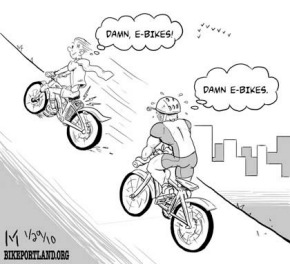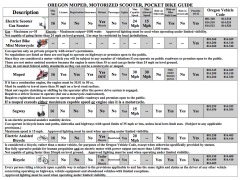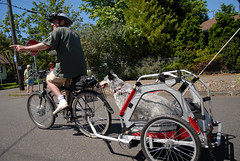
Whether you like them or not, electric bikes have arrived and it looks like they’re here to stay. E-bikes can now be found in almost every local bike shop, major manufacturers are adding e-assist to a growing number of urban and cargo bikes, and e-bikes can be spotted among bike traffic more and more. But what about the laws governing their specifications and usage?
This isn’t intended to be legal advice, as I’m not a lawyer, but a brief summary of e-bike related law at the federal, state, and local levels.
Federal Law
At the Federal level, the National Highway Traffic Safety Administration (NHTSA) relegated defining what an e-bike is to the Consumer Product Safety Commission (CPSC). The CPSC defines a low-speed electric bicycle as:
“… a two- or three-wheeled vehicle with fully operable pedals and an electric motor of less than 750 watts (1 h.p.), whose maximum speed on a paved level surface, when powered solely by such a motor while ridden by an operator who weighs 170 pounds, is less than 20 mph. (Public Law No. 107-319, section 1, 116 Stat. 2776 (2002))”
This law is also known as HR 727 (co-sponsored by Oregon’s own Representative Earl Blumenauer). Since this is a CPSC ruling, it only defines what safety requirements are required to sell an electric bicycle; it in no way legislates their usage.
Also at the Federal level, under Title 23, Chapter 2, §217,
(h) Use of Motorized Vehicles.— Motorized vehicles may not be permitted on trails and pedestrian walkways under this section, except for—…
(4) when State or local regulations permit, electric bicycles…
For the purposes of this statute, an electric bicycle is “any bicycle or tricycle with a low-powered electric motor weighing under 100 pounds, with a top motor-powered speed not in excess of 20 miles per hour.”
In short, at the federal level there are some restrictions defining e-bikes for the purposes of sales, but the decision to allow e-bikes is specifically delegated to the state or local level.
Oregon State Law
At the state level, e-bikes are touched on by the Oregon Revised Statutes (ORS) in several places. First, state law clearly says that e-bikes are legally considered to be bikes:
814.405 – Status of electric assisted bicycle
An electric assisted bicycle shall be considered a bicycle, rather than a motor vehicle, for purposes of the Oregon Vehicle Code, except when otherwise specifically provided by statute.
And here’s the Oregon Department of Transportation’s (ODOT) definition of an e-bike:
801.258 “Electric assisted bicycle” means a vehicle that:
(1) Is designed to be operated on the ground on wheels;
(2) Has a seat or saddle for use of the rider;
(3) Is designed to travel with not more than three wheels in contact with the ground;
(4) Has both fully operative pedals for human propulsion and an electric motor; and
(5) Is equipped with an electric motor that:
(a) Has a power output of not more than 1,000 watts; and
(b) Is incapable of propelling the vehicle at a speed of greater than 20 miles per hour on level ground.
Although Oregon’s watt limitation is higher than the federal limit, Oregon statute largely follows the federal intent. There are some additional e-bike specific statutes:
814.410 Unsafe operation of bicycle on sidewalk
(1) A person commits the offense of unsafe operation of a bicycle on a sidewalk if the person does any of the following:…
(e) Operates an electric assisted bicycle on a sidewalk.
807.020 Exemptions from requirement to have Oregon license or permit…
(14) A person may operate an electric assisted bicycle without a driver license or driver permit if the person is 16 years of age or older.

ODOT has compiled an informational page summarizing the law as it pertains to bikes, e-bikes, pocket bikes, and other vehicles. You can download the PDF here.
Portland City Code
At the local level, the Portland Bureau of Transportation (PBOT) uses the ODOT definition of e-bikes in determining whether or not e-bikes are legally allowed to use bicycle infrastructure. This ensures consistency at the state and local levels.
Washington State Law (and beyond)
Washington state law is similar to Oregon law, though Washington law further requires wearing a helmet, and requires that the motor not provide additional power above 20 miles per hour. Some other jurisdictions have enacted their own e-bike regulations – for instance, e-bikes are illegal on all streets in New York State, though they are widely used as delivery vehicles in New York City. In Ontario, Canada, they recently completed a three-year test program to determine whether e-bikes could be safely integrated into regular bicycle traffic; their conclusion was to legalize e-bikes, albeit with some additional safety requirements around total weight, braking, and helmet usage.
In practice, e-bikes that are compliant with the above regulations are legally bicycles, and on one you are entitled to the same rights and responsibilities of automobile drivers, as well as other people on bikes. On a typical e-bike frame, 750 or 1,000 watts is going to be excessively powerful; in practice, 250-500 watts is sufficient for most riders. Heavier scooter-inspired e-bikes, legally still e-bikes, may need more power and bump against this limitation, as might e-bikes designed to carry cargo.
The 20 miles per hour is a reasonable speed limit – of course, it’s more important to flow safely with traffic than always ride at the legal speed limit. Other countries limit e-bike speeds to 15 miles per hour; these models tend to feel underpowered on US roads. Finally, a restriction against riding on the sidewalk makes a lot of sense, even if you’re not on an e-bike.
— The article was written by Sam Hass, author of pdxebiker, a blog for discussion of electrically assisted bicycling in Portland. For more articles on e-bikes, browse the BikePortland archives.



